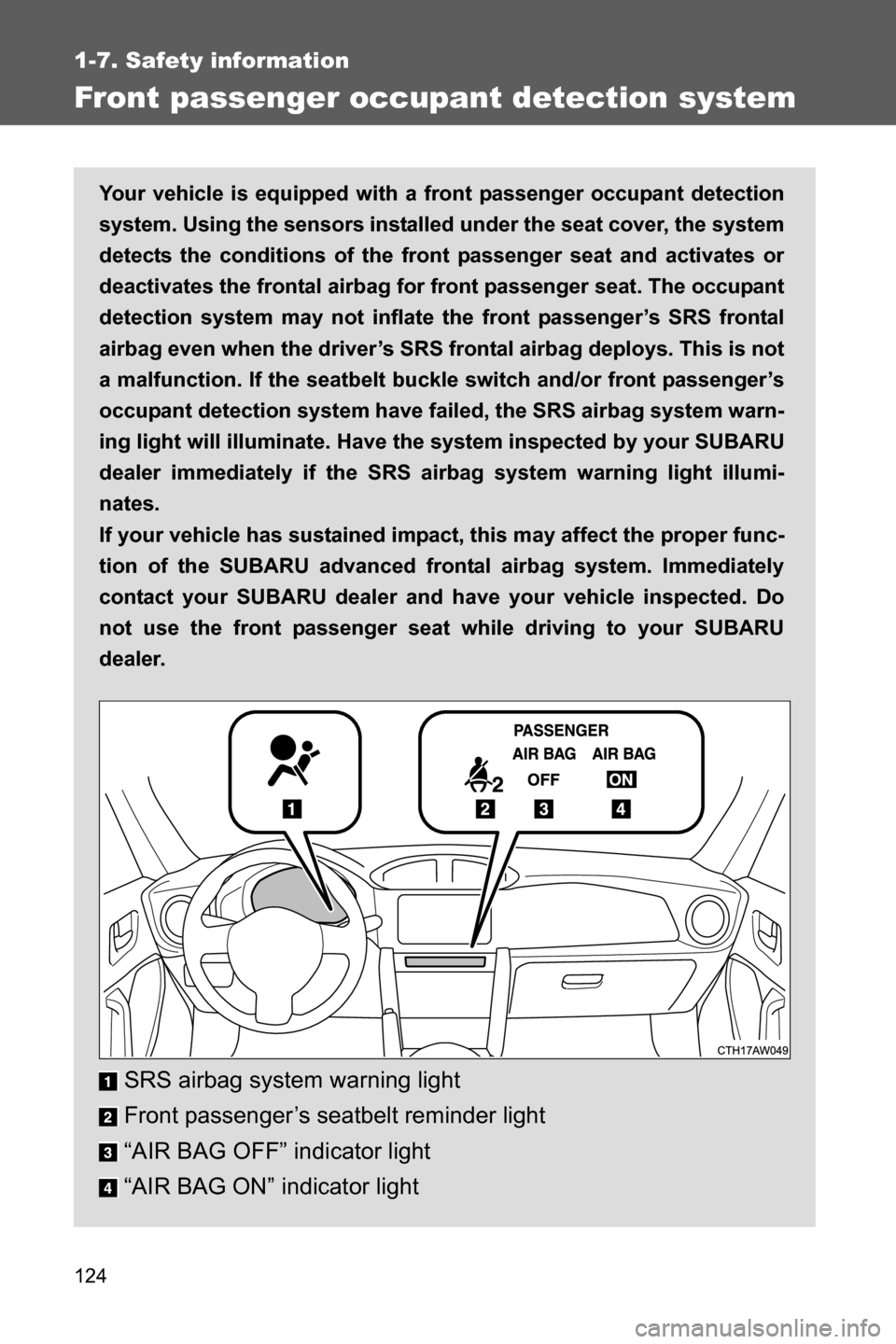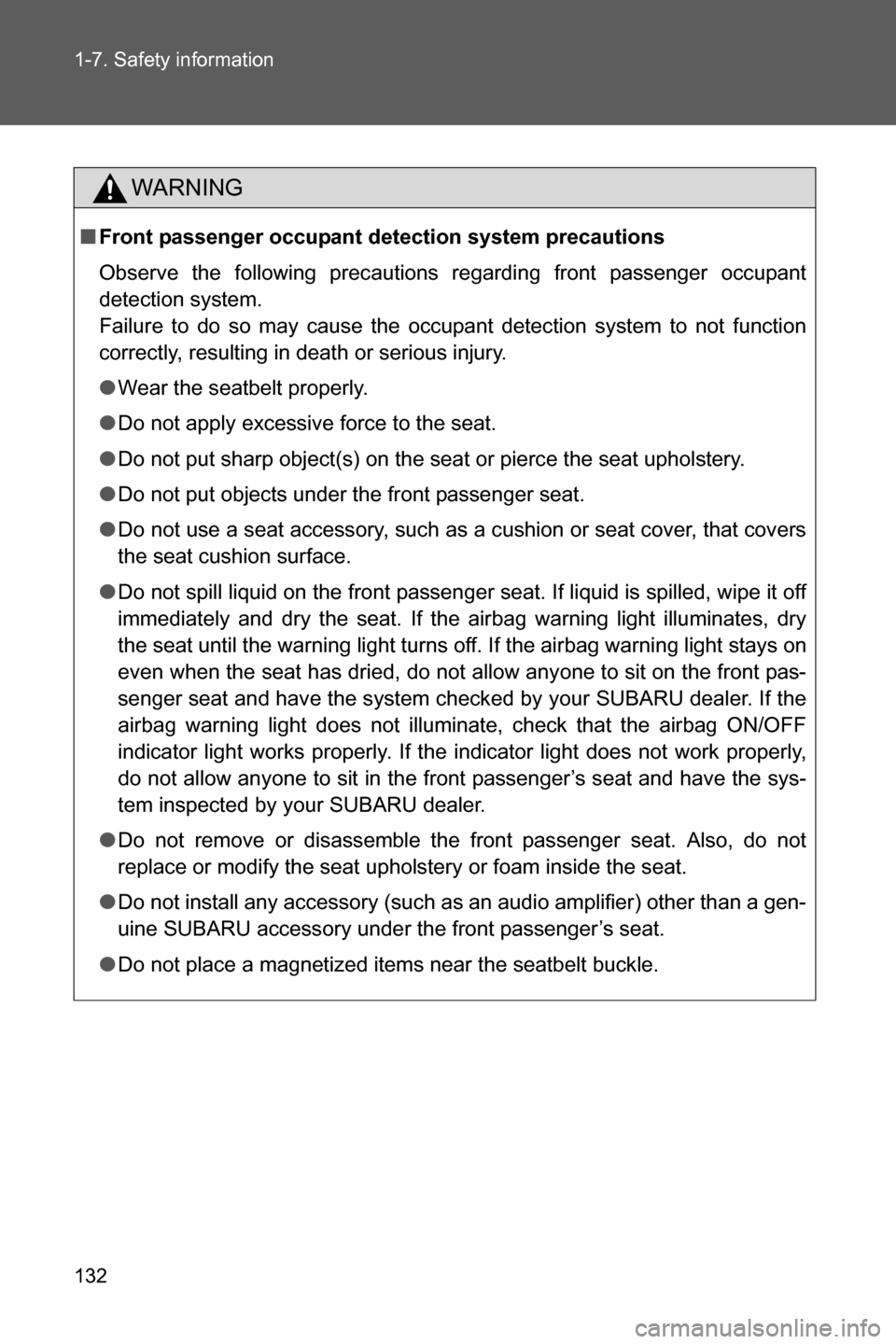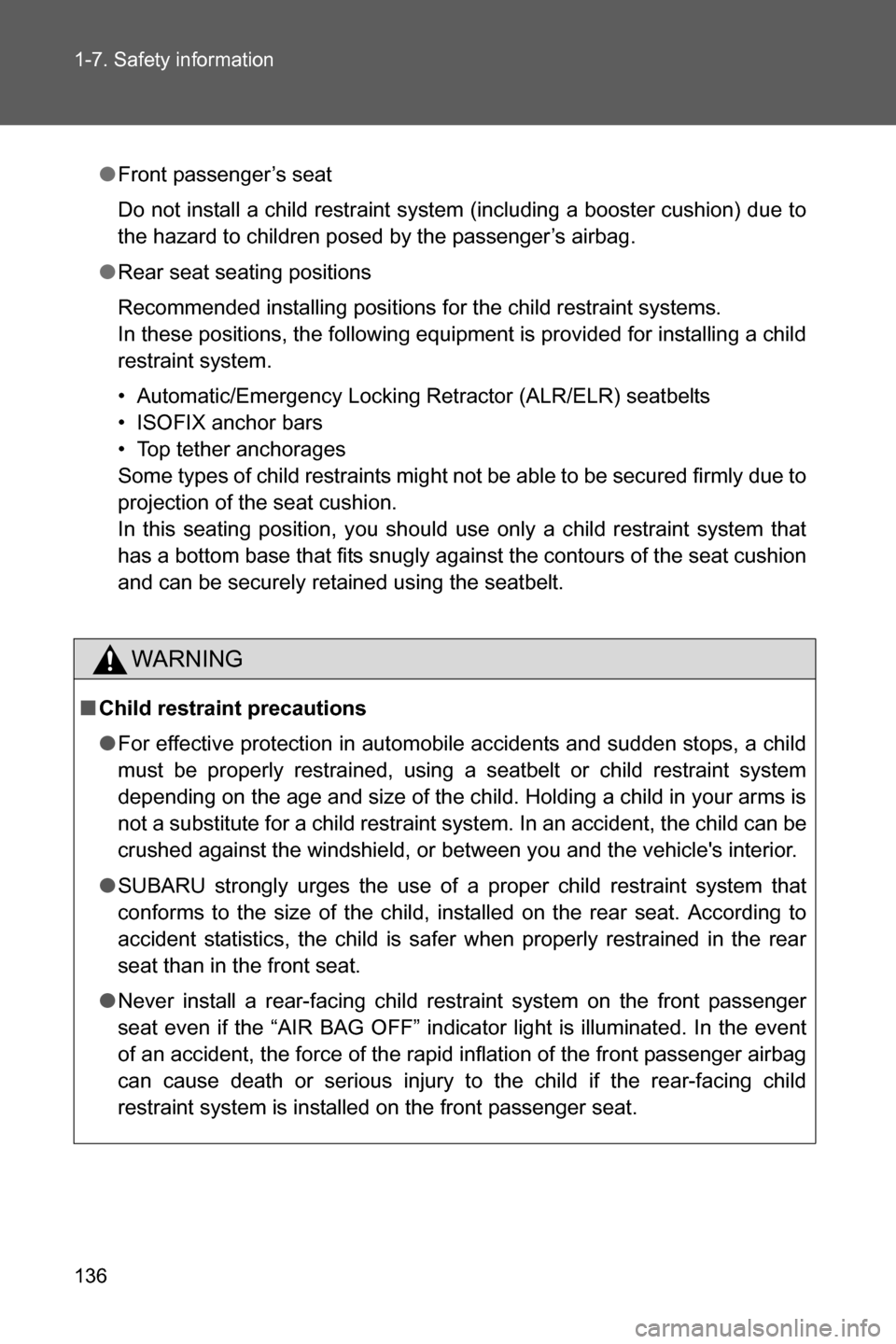Page 125 of 490

124
1-7. Safety information
Front passenger occupant detection system
Your vehicle is equipped with a front passenger occupant detection
system. Using the sensors installed under the seat cover, the system
detects the conditions of the front passenger seat and activates or
deactivates the frontal airbag for front passenger seat. The occupant
detection system may not inflate the front passenger’s SRS frontal
airbag even when the driver’s SRS frontal airbag deploys. This is not
a malfunction. If the seatbelt buckle switch and/or front passenger’s
occupant detection system have failed, the SRS airbag system warn-
ing light will illuminate. Have the system inspected by your SUBARU
dealer immediately if the SRS airbag system warning light illumi-
nates.
If your vehicle has sustained impact, this may affect the proper func-
tion of the SUBARU advanced frontal airbag system. Immediately
contact your SUBARU dealer and have your vehicle inspected. Do
not use the front passenger seat while driving to your SUBARU
dealer.
SRS airbag system warning light
Front passenger’s seatbelt reminder light
“AIR BAG OFF” indicator light
“AIR BAG ON” indicator light
Page 127 of 490
126 1-7. Safety information
Condition and operation in the front passenger occupant
detection system*1
■Adult*2
■Child restraint system with infant*6, *7, *8
Indicator/
warning light“AIR BAG ON” and “AIR BAG OFF”
indicator lights“AIR BAG
ON”
SRS airbag system warning light Off
Front passenger’s seatbelt reminder light
Flashing
*3
DevicesFront passenger airbag
On Front side airbag
*4
Front curtain airbag*4
Front passenger’s seatbelt pretensioner*4
Indicator/
warning light“AIR BAG ON” and “AIR BAG OFF”
indicator lights“AIR BAG
OFF”*9
SRS airbag system warning light
Off
Front passenger’s seatbelt reminder light
DevicesFront passenger airbag Off
Front side airbag
*4
On
Front curtain airbag*4
Front passenger’s seatbelt pretensioner*4
Page 128 of 490

127 1-7. Safety information
1
Before driving
■Child*5, *7
■Unoccupied
■There is a malfunction in the system
Indicator/
warning light“AIR BAG ON” and “AIR BAG OFF”
indicator lights“AIR BAG
OFF” or “AIR
BAG ON”*5
SRS airbag system warning light Off
Front passenger’s seatbelt reminder lightOff or
flashing
*3, *5
DevicesFront passenger airbag Off or on
*5
Front side airbag*4
On
Front curtain airbag*4
Front passenger’s seatbelt pretensioner*4
Indicator/
warning light“AIR BAG ON” and “AIR BAG OFF”
indicator lights“AIR BAG
OFF”
SRS airbag system warning light
Off
Front passenger’s seatbelt reminder light
DevicesFront passenger airbag Off
Front side airbag
*4
On
Front curtain airbag*4
Front passenger’s seatbelt pretensioner*4
Indicator/
warning light“AIR BAG ON” and “AIR BAG OFF”
indicator lights“AIR BAG
OFF”
SRS airbag system warning light On
Front passenger’s seatbelt reminder light Off
DevicesFront passenger airbag Off
Front side airbag
*4
On
Front curtain airbag*4
Front passenger’s seatbelt pretensioner*4
Page 133 of 490

132 1-7. Safety information
WARNING
■Front passenger occupant detection system precautions
Observe the following precautions regarding front passenger occupant
detection system.
Failure to do so may cause the occupant detection system to not function
correctly, resulting in death or serious injury.
●Wear the seatbelt properly.
●Do not apply excessive force to the seat.
●Do not put sharp object(s) on the seat or pierce the seat upholstery.
●Do not put objects under the front passenger seat.
●Do not use a seat accessory, such as a cushion or seat cover, that covers
the seat cushion surface.
●Do not spill liquid on the front passenger seat. If liquid is spilled, wipe it off
immediately and dry the seat. If the airbag warning light illuminates, dry
the seat until the warning light turns off. If the airbag warning light stays on
even when the seat has dried, do not allow anyone to sit on the front pas-
senger seat and have the system checked by your SUBARU dealer. If the
airbag warning light does not illuminate, check that the airbag ON/OFF
indicator light works properly. If the indicator light does not work properly,
do not allow anyone to sit in the front passenger’s seat and have the sys-
tem inspected by your SUBARU dealer.
●Do not remove or disassemble the front passenger seat. Also, do not
replace or modify the seat upholstery or foam inside the seat.
●Do not install any accessory (such as an audio amplifier) other than a gen-
uine SUBARU accessory under the front passenger’s seat.
●Do not place a magnetized items near the seatbelt buckle.
Page 137 of 490

136 1-7. Safety information
●Front passenger’s seat
Do not install a child restraint system (including a booster cushion) due to
the hazard to children posed by the passenger’s airbag.
●Rear seat seating positions
Recommended installing positions for the child restraint systems.
In these positions, the following equipment is provided for installing a child
restraint system.
• Automatic/Emergency Locking Retractor (ALR/ELR) seatbelts
• ISOFIX anchor bars
• Top tether anchorages
Some types of child restraints might not be able to be secured firmly due to
projection of the seat cushion.
In this seating position, you should use only a child restraint system that
has a bottom base that fits snugly against the contours of the seat cushion
and can be securely retained using the seatbelt.
WARNING
■Child restraint precautions
●For effective protection in automobile accidents and sudden stops, a child
must be properly restrained, using a seatbelt or child restraint system
depending on the age and size of the child. Holding a child in your arms is
not a substitute for a child restraint system. In an accident, the child can be
crushed against the windshield, or between you and the vehicle's interior.
●SUBARU strongly urges the use of a proper child restraint system that
conforms to the size of the child, installed on the rear seat. According to
accident statistics, the child is safer when properly restrained in the rear
seat than in the front seat.
●Never install a rear-facing child restraint system on the front passenger
seat even if the “AIR BAG OFF” indicator light is illuminated. In the event
of an accident, the force of the rapid inflation of the front passenger airbag
can cause death or serious injury to the child if the rear-facing child
restraint system is installed on the front passenger seat.
Page 148 of 490

When driving2
147
2-1. Driving procedures
Driving the vehicle............ 148
Push-button ignition
switch ............................. 162
Engine (ignition)
switch ............................. 171
Automatic
transmission................... 174
Manual Transmission ....... 181
Turn signal lever .............. 184
Parking brake ................... 185
Horn ................................. 186
2-2. Instrument cluster
Gauges and meters ......... 187
Indicators and warning
lights .............................. 192
Multi-information
display............................ 1972-3. Operating the lights and
windshield wipers
Headlight switch ............... 202
Fog light switch ................ 208
Windshield wipers and
washer ........................... 209
2-4. Using other driving
systems
Cruise control ................... 212
Driving assist systems ..... 217
2-5. Driving information
Cargo and luggage .......... 224
Vehicle load limits ............ 228
Winter driving tips ............ 229
Trailer towing ................... 234
Dinghy towing .................. 235
Page 151 of 490

150 2-1. Driving procedures
Starting off on a steep uphill
Vehicles with an automatic transmission
Make sure that the parking brake is set and shift the select
lever to D.
Gently depress the accelerator pedal.
Release the parking brake.
Vehicles with a manual transmission
With the parking brake firmly set and the clutch pedal fully
depressed, shift the shift lever to 1.
Lightly depress the accelerator pedal at the same time as
gradually releasing the clutch pedal.
Release the parking brake.
■Driving in the rain
●Drive carefully when it is raining, because visibility will be reduced, the
windows may become fogged-up, and the road will be slippery.
●Drive carefully when it starts to rain, because the road surface will be
especially slippery.
●Refrain from high speeds when driving on an expressway in the rain,
because there may be a layer of water between the tires and the road
surface, preventing the steering and brakes from operating properly.
■Engine speed while driving (vehicles with an automatic transmission)
In the following conditions, the engine speed may become high while driving.
This is due to automatic up-shifting control or down-shifting implementation
to meet driving conditions. It does not indicate sudden acceleration.
●The vehicle is judged to be driving uphill or downhill
●When the accelerator pedal is released
●When driving on curves
●When the brake pedal is firmly depressed
STEP 1
STEP 2
STEP 3
STEP 1
STEP 2
STEP 3
Page 152 of 490
![SUBARU BRZ 2016 1.G Owners Manual 151 2-1. Driving procedures
2
When driving
■New vehicle break-in driving (the first 1000 miles [1600 km])
The performance and long life of your vehicle are dependent on how you
handle and care for y SUBARU BRZ 2016 1.G Owners Manual 151 2-1. Driving procedures
2
When driving
■New vehicle break-in driving (the first 1000 miles [1600 km])
The performance and long life of your vehicle are dependent on how you
handle and care for y](/manual-img/17/7183/w960_7183-151.png)
151 2-1. Driving procedures
2
When driving
■New vehicle break-in driving (the first 1000 miles [1600 km])
The performance and long life of your vehicle are dependent on how you
handle and care for your vehicle while it is new. Follow these instructions
during the first 1000 miles (1600 km):
●Do not allow the engine speed to exceed 4000 rpm except in an emer-
gency.
●Do not drive at one constant engine or vehicle speed for a long time,
either fast or slow.
●Avoid starting suddenly and rapid acceleration, except in an emergency.
●Avoid hard braking, except in an emergency.
The same break-in procedures should be applied to an overhauled engine,
newly mounted engine or when brake pads or brake linings are replaced
with new ones.
■Replacement of brake pad and lining
The front disc brake and the rear disc brake have audible wear indicators on
the brake pads. If the brake pads wear close to their service limit, the wear
indicator makes a very audible scraping noise when the brake pedal is
applied.
■Breaking-in of new brake pads and linings
When replacing the brake pad or lining, use only genuine SUBARU parts.
After replacement, the new parts must be broken in as follows.
Brake pad and lining
While maintaining a speed of 30 to 40 mph (50 to 65 km/h), step on the
brake pedal lightly. Repeat this five or more times.If you hear this scraping noise each time
you apply the brake pedal, have the
brake pads serviced by your SUBARU
dealer as soon as possible.